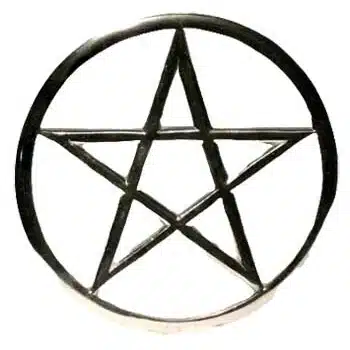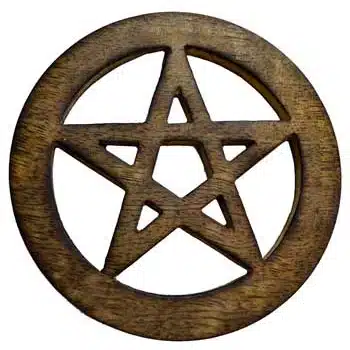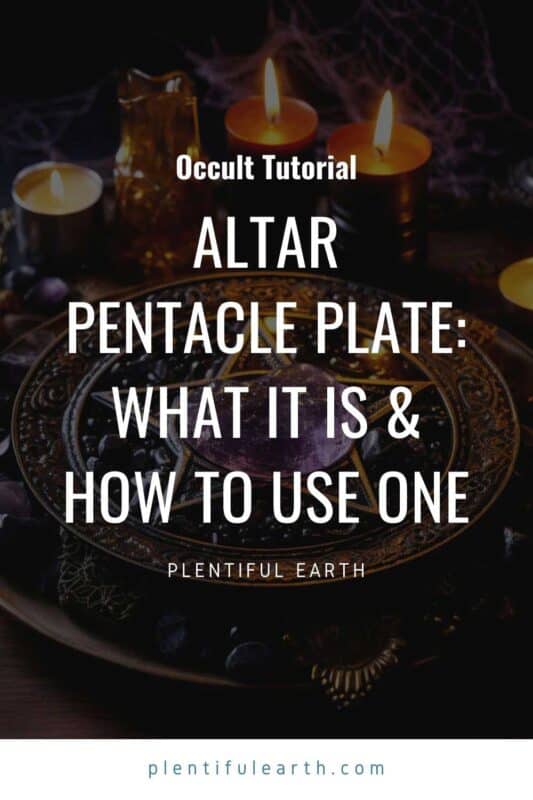Is your spellbook asking you to place your items onto an altar tile?
Wondering what it is or where you should get one?
This guide is perfect for beginner Witches or anyone who is exploring the world of Wicca!
Table of Contents
A pentacle plate, also known as an altar pentacle or altar tile, serves as a significant tool in various modern Pagan and occult practices, such as Wicca and ceremonial magic.
This sacred item typically features an inscribed or engraved pentagram symbol on a round or square plate. It is often placed at the center of the altar and is used for consecration, offering, or as a focal point during rituals and spellwork.
The pentacle plate holds symbolic meaning, representing the five elements of earth, air, fire, water, and spirit, harmoniously interconnected and balanced. It is considered a powerful tool for channeling energy and invoking spiritual forces.
What Does A Pentacle Altar Tile or Pentacle Plate Look Like?
A pentacle plate usually takes the form of a flat disc or plate made of metal, wood, stone, glass, or clay, inscribed with a pentagram (a five-pointed star) surrounded by a circle.


Sometimes, other symbols, such as the elemental symbols, may be incorporated.
How Do You Use An Altar Tile Or Pentacle Plate?
The pentacle serves multiple purposes in magical and religious rituals:
- Symbolic Representation: The pentacle often represents the element of Earth within the framework of the four classical elements (Earth, Air, Fire, Water), serving as a grounding point for the practitioner’s energy and intentions.
- Protective Talisman: The pentagram itself is a symbol of protection, with its continuous line believed to ward off negative energies and spirits. When used in ritual, the pentacle plate can act as a protective barrier.
- Consecration or Empowering Tool: It is commonly placed on altars to consecrate objects, such as during the ritual of casting a circle, where it might be used to symbolize the Earth and its stability.
- Focal Point for Magic: Practitioners may use the pentacle as a focus for magical workings, placing objects upon it to be charged with energy, consecrated, or used in spellwork.
Brief History & Origin Of Pentacle Plates
The use of symbols similar to the pentagram dates back to ancient civilizations, including the Sumerians, Babylonians, and Greeks, where it was used in religious and mystical contexts.
However, the pentacle plate, as used in modern Pagan and occult practices, has its roots more directly in the Western esoteric tradition, evolving from the Renaissance period onwards.
Who Made Altar Tiles & Pentacles Popular
The widespread use and popularization of the pentacle within modern magical and religious practices can be attributed to several key figures and movements:
- Eliphas Levi: A French occultist of the 19th century, Levi was one of the first to associate the pentagram with magical and esoteric principles, tying it to the elements and the human form.
- The Hermetic Order of the Golden Dawn: This late 19th to early 20th-century organization was instrumental in developing the ceremonial magic tradition, within which the pentacle was used as a tool for invoking and banishing elemental forces.
- Gerald Gardner: Often considered the father of Wicca, Gardner introduced the pentacle into the religion’s ritual practices in the mid-20th century, drawing from earlier esoteric traditions and incorporating it as a key element of Wiccan altar setups.
- Aleister Crowley: His work in Thelema and ceremonial magic further popularized the use of the pentacle, among other esoteric symbols, within modern occultism.
The pentacle continues to be a central element of many Pagan and magical practices, embodying both the rich history of esoteric and religious symbolism and the practical applications within ritual magic.




